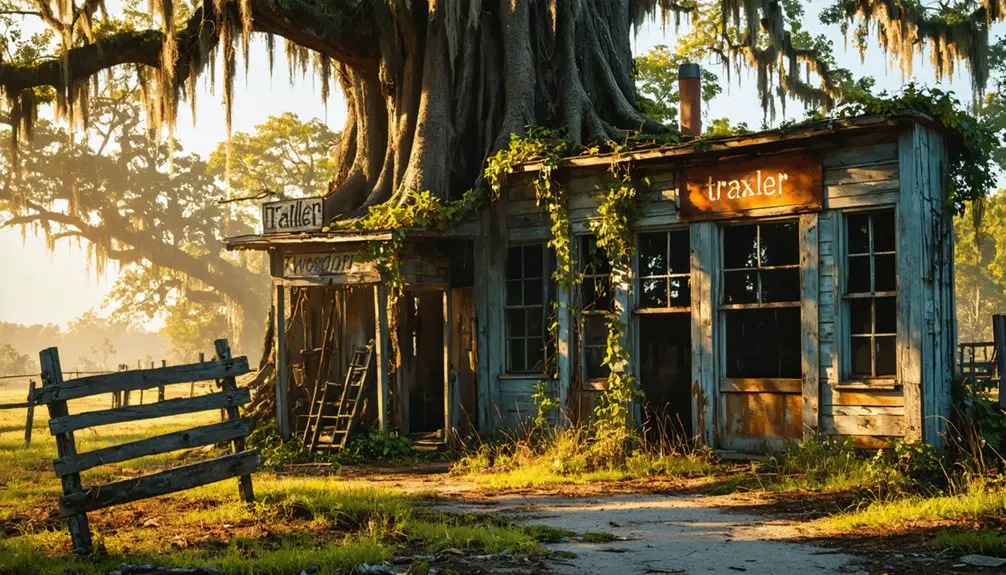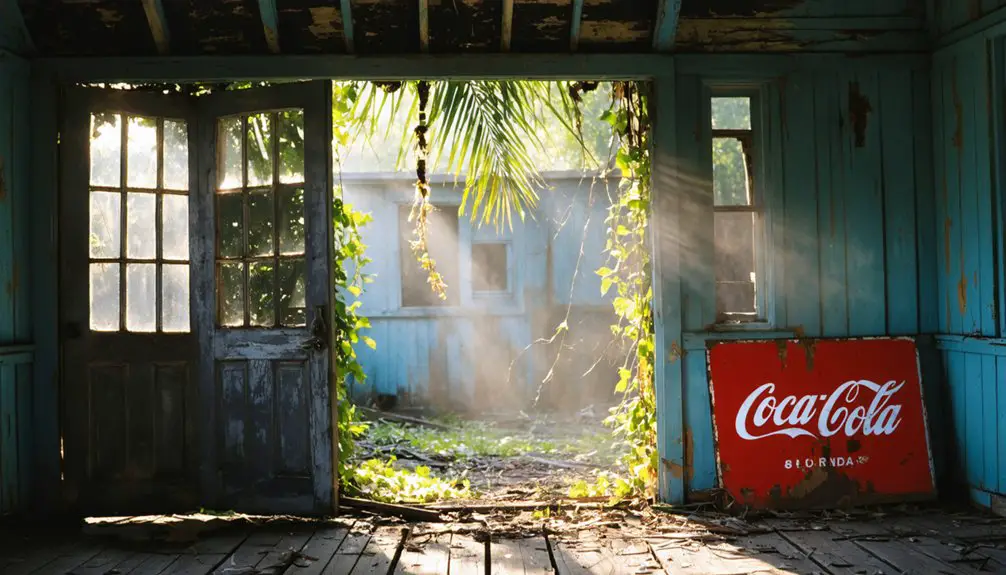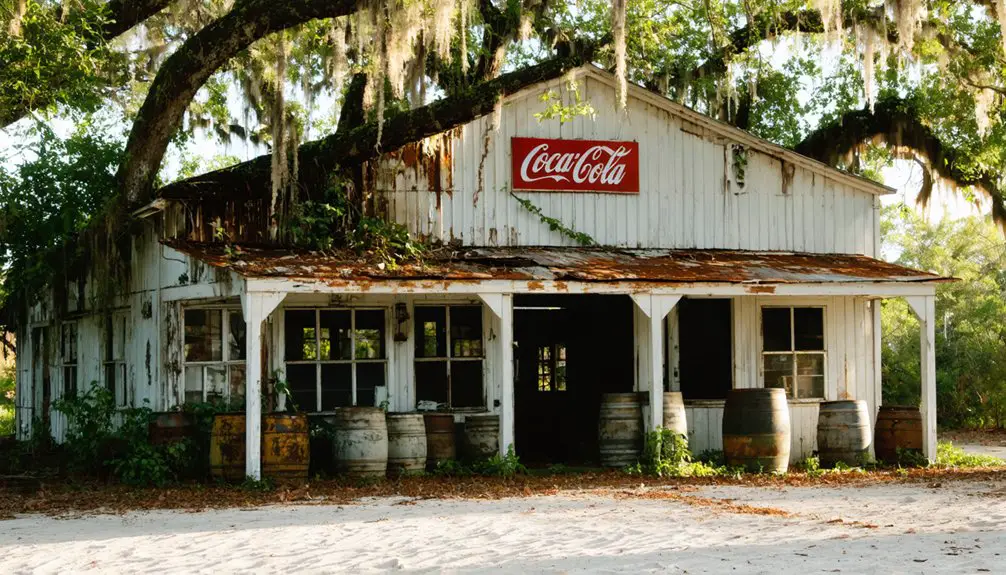You’ll find the ghost town of Traxler along historic Bellamy Road in Alachua County, Florida, where William H. Traxler established a thriving cotton farming community in the 1880s. The settlement once boasted a general store, cotton gin, grist mill, schoolhouse, and post office, with Spring Hill United Methodist Church serving as its social hub. Today, only scattered remnants and the restored church building survive, offering glimpses into Florida’s pioneer past and untold stories of early settler life.
Key Takeaways
- Traxler was a cotton farming settlement in Alachua County, Florida, established in the 1880s along historic Bellamy Road.
- The town featured essential infrastructure including a cotton gin, grist mill, general store, post office, and schoolhouse.
- Spring Hill United Methodist Church, built in 1860 and rebuilt in 1915, remains the only significant structure still standing.
- Economic decline began with the cotton industry’s collapse and worsened when the railroad bypassed the town.
- The post office closed in 1906, and nature has reclaimed most of the town, leaving only scattered remnants visible today.
The Origins and Founding Family

Although many Florida ghost towns faded into obscurity, Traxler’s origins can be traced to William H. Traxler, born in 1854 near Columbia County’s natural bridge.
As part of Florida’s pioneering heritage, he ventured to Alachua County in the 1880s, establishing his roots along the historic Bellamy Road – Florida’s first federal highway. To prevent confusion with other Traxler namesakes, historical records often include disambiguation notes to distinguish this location from others.
The founding significance of Traxler grew when he married Mary Lelia Dell in 1889, uniting two prominent settler families. The area’s connection to history remains evident through Spring Hill Church, which celebrated its 150th anniversary in 2010.
His South Carolina ancestry and determination to carve out a new life led him to develop a thriving community centered around cotton farming.
Starting with a general store, he expanded his influence by acquiring more land and building essential infrastructure that would serve as the backbone of this once-prosperous settlement.
Life Along Historic Bellamy Road
If you’d traveled along Florida’s first federally funded road in the 1820s, you’d have encountered Bellamy Road‘s 16-foot-wide path connecting St. Augustine to Tallahassee.
Along this essential transportation artery, communities like Traxler emerged as agricultural and commercial hubs, with William Traxler’s store, cotton gin, and grist mill serving local farmers and residents. The rough terrain and numerous stumps along the path earned it the nickname Stump-Knocker among travelers.
The road’s presence shaped settlement patterns throughout northern Alachua County, enabling trade networks that supported cotton farming communities while fostering social connections through institutions like Spring Hill Methodist Church. The roadway required extensive labor to construct, with contractor John Bellamy winning the bid for $13,500.
Early Transportation Routes
When Congress authorized the construction of Bellamy Road in 1824, they envisioned an essential transportation link between Pensacola and St. Augustine.
This transportation innovation transformed Florida’s interior, opening up previously isolated regions and establishing critical rural connectivity across the territory. The Old Bellamy Road became a vital route for settlers in northern Alachua County, including the emerging Traxler community. The road largely followed the path of El Camino Real, a historic Spanish route that had fallen into disuse.
Captain Daniel Burch led the ambitious 445-mile survey, while plantation owner John Bellamy won the bid to construct a key segment using slave labor and Native American guides.
- You’d encounter a 16-foot-wide path, narrower than Congress’s prescribed 25 feet
- You’ll find wagon wheels bouncing over protruding stumps, earning it the nickname “Stump Knocker Road”
- You’d see inadequate bridges testing travelers’ patience
- You’d notice how tight passages prevented two wagons from passing simultaneously
Trade and Settlement Patterns
As Bellamy Road shaped Florida’s interior development in the 1820s, the town of Traxler emerged as a quintessential cotton farming settlement along its route in northern Alachua County.
You’ll find that trade networks centered around the town’s cotton gin and grist mill, where local farmers processed their harvests before transport to larger markets.
The settlement’s dynamics reflected a typical pattern you’d see in the era: a clustered community with farms, a general store, church, post office, and school forming tight nodes of activity along the road.
The arrival of the Florida Railroad opened new opportunities for farmers to transport their goods more efficiently to distant markets.
Native American guides helped establish this vital transportation corridor when the road was completed in 1826, creating lasting impact on settlement patterns.
From 1891 to 1906, Traxler’s post office connected residents to wider commercial networks, while the general store served as both a retail hub and informal trading center for farmers and travelers moving along Bellamy Road.
Community Life 1820s-1900s
Life along Bellamy Road in Traxler revolved around a tight-knit community structure shaped by cotton farming, faith, and education.
You’d find the heart of social activity at Spring Hill United Methodist Church, where community gatherings fostered unity and spiritual connection since 1860.
Educational practices centered on a one-room schoolhouse, adapting to agricultural rhythms as children balanced learning with cotton harvest demands. Spanish explorers in the early mission period had traversed this same path centuries before the community emerged.
- Church bells echoing across cotton fields, calling families to Sunday worship
- Children’s voices carrying from the schoolhouse as they practice their lessons
- Farmers gathering at Traxler’s store to trade goods and share news
- The steady hum of the cotton gin during harvest season
Daily life wove together at these essential gathering spots, where you’d witness the close bonds of rural Florida society emerging through shared work, worship, and learning.
The remnants of this once-bustling community now draw visitors traveling along the Old Bellamy Road, offering glimpses into Florida’s rich heritage.
Agricultural Legacy and Economic Activities
Founded by William H. Traxler in the late 1800s along Bellamy Road, this agricultural settlement quickly established itself as a vibrant farming community in Alachua County.
You’ll find the roots of Traxler’s economy in cotton production, supported by crucial infrastructure including a cotton gin and grist mill. The settlement’s commitment to crop diversification led to the introduction of tobacco and various vegetables, strengthening its agricultural foundation.
The Traxler Country Store and commissary, operating from 1889 to 1941, served as the community’s commercial hub, providing essential supplies to farming families within a 25-mile radius.
The agricultural system relied on tenant farming, with workers living on the land and participating in seasonal labor cycles. Local processing facilities, including a cane press and syrup cooling houses, enabled farmers to add value to their harvests.
Community Landmarks and Infrastructure

While Traxler’s physical footprint has largely faded, the Spring Hill United Methodist Church stands as the town’s most enduring landmark, dating back to its 1860 founding by Simeon Dell, Fernando Underwood, and three other pioneers.
Built with local lumber, the church survived an 1896 windstorm before being rebuilt in 1915, continuing to serve as a crucial hub for community gatherings and church events.
Key elements that once defined Traxler’s infrastructure include:
- William H. Traxler’s general store, which provided essential commerce and credit
- A cotton gin and grist mill for processing agricultural products
- A one-room schoolhouse serving local families
- A post office that operated from 1891 to 1906, connecting residents to the outside world
You’ll find the church’s adjacent cemetery still preserves the legacy of the area’s pioneer families.
The Gradual Decline of a Rural Settlement
During the late 1800s, Traxler’s heavy reliance on cotton farming set the stage for its eventual decline, as the community failed to diversify beyond this single economic pillar.
You’ll find that this economic vulnerability became painfully apparent when the cotton industry collapsed, triggering a wave of population migration as families sought opportunities elsewhere.
The town’s isolation deepened when the railroad bypassed it, while natural disasters and storms damaged essential buildings.
You can trace Traxler’s downward spiral through the closure of important institutions – the post office shut down in 1906, the cotton gin was abandoned, and the one-room schoolhouse ceased operations.
As each generation left, the social fabric unraveled, leaving only Spring Hill United Methodist Church as a lasting reminder of the once-thriving community.
What Remains Today: A Historical Journey

As you travel through the remnants of Traxler today, you’ll find a landscape where nature has steadily reclaimed much of the former settlement, leaving only scattered traces of its past.
The Spring Hill United Methodist Church, founded in 1860, stands as the most prominent reminder of Traxler’s historical significance, while ghost town exploration reveals:
Spring Hill United Methodist Church rises above Traxler’s ghostly landscape, a sentinel of history since 1860.
- Original houses scattered throughout the wooded area, offering glimpses into pioneer life
- The historic Bellamy Road corridor, still accessible and marking ancient pathways
- Weathered tenant farm homes and agricultural site remnants hidden in the undergrowth
- A memorial marker commemorating the town’s heritage and former residents
You’ll notice the wilderness has transformed this once-bustling community, though dedicated historians and visitors continue documenting its remaining structures, ensuring Traxler’s story endures despite nature’s inevitable advance.
Frequently Asked Questions
What Happened to William Traxler’s Descendants After the Town’s Decline?
You’ll find Traxler descendants maintained their family legacy through Spring Hill Methodist Church, while many dispersed to nearby towns as farming declined and economic opportunities shifted away from their ancestral community.
Were There Any Notable Crimes or Incidents in Traxler’s History?
You won’t find ghostly encounters or crime reports here – historical records show no major criminal activity in this quiet farming community. The only thing that vanished was the town itself.
What Was the Peak Population of Traxler During Its Prime?
You won’t find exact Traxler demographics or population statistics documented in historical records, though the town’s infrastructure of a store, gin, school, and church suggests a modest rural farming community.
Did Any Famous People Ever Visit or Pass Through Traxler?
You won’t find any documented evidence of famous visitors or historical figures passing through Traxler, though local travelers used the Bellamy Road nearby for regional trade and transport.
What Natural Disasters or Events Affected the Town Before Abandonment?
While you might expect dramatic natural disasters to have struck this old Florida town, historical records don’t show any major environmental changes or catastrophic events affecting Traxler before its gradual abandonment.
References
- https://en.wikipedia.org/wiki/Traxler
- https://www.tiktok.com/@beyondflorida/video/7313617827473165614
- http://chazzcreations.com/alachua_county_historic_towns/traxler
- https://mapcarta.com/20697124
- https://www.youtube.com/watch?v=LAHmhtXE6DY
- https://www.alachuacountytoday.com/index.php?option=com_content&view=article&id=793:opening-a-window-to-the-past-local-church-celebrates-150-years&catid=102:local&Itemid=426
- http://www.desolationflorida.com/2015/10/traxler-florida.html
- https://kids.kiddle.co/Traxler
- https://www.alachuacountytoday.com/news-featured/latest/4139-bellamy-road-one-of-america-s-oidest-roads
- https://www.wuft.org/florida-good/2022-02-28/two-historical-markers-unveiled-in-alachua-help-preserve-prominent-church-community



